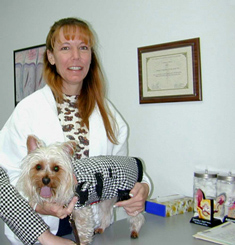Dressing Your Pet:
When to Dress Your Pet

As most of you realize, the dedicated
pet owner/guardian has a tendency to humanize their
pets. And rightly so, since pets are and should be considered
part of the family. Sometimes, we let our motherly or
fatherly instincts get the best of us when viewing pets
as our "children".
Please remember that dogs and cats, with
the exception of some, have their natural coats to keep
them warm in the winter and insulated in the summer.
A little common sense can do wonders.
For example, the origin of a hairless Chihuahua began
in a very hot Mexican climate. However, through the
ages, many of these dogs have been transported to areas
all over the world, including very cold climates. They
are ideal candidates for clothing. On the other hand,
Alaskan Eskimo dogs, obviously created for cold climates,
are living in tropical areas and therefore need not
wear clothing.
Your "child" will let you know
when or if he/she wants to be dressed.
Below are some do's and don'ts when
making the decision whether or not to dress your pet.
Do Dress Your Pets:
- If they are hairless, short-haired
or mid-haired or have a long, thin coat.
- By slowly breaking them in little
by little. Try to combine their coat or sweater along
with their leash when taking them for a walk, shopping
or other social functions. They will gradually get
the idea and will associate the clothes with a good
time.
- If you live in a cold climate where
they will be outside for a lengthy duration of time
or live in doghouses (which we do not advise as this
may cause joint pain such as arthritis and other medical
problems, just as in humans, your pet should NEVER
be left out in cold weather).
- When shopping during cool weather,
but if you plan to stay in a store for a while, your
pet may become overheated, so remember to loosen,
unbutton, unzip or remove the clothing during that
time.
- During cool summer evenings, but only
in a very lightweight t-shirt.
- Only if they enjoy wearing the clothes.
Don't Dress Your Pets:
- If you live in a hot climate where
temperatures exceed the norm. Doing so may cause your
pet to encounter heat stroke.
- If they have a full, thick, dense
coat.
- In tight clothing. Please make sure
the clothing is roomy and comfortable.
- If they struggle with the clothes
even after you've tried the break-in process. Some
pets just don't want to be dressed, so please DON’T
FORCE.
Veterinary
Visits:
Stay Healthy

Amber realizes that her health is very
important. Here, she visits her Veterinarian, Dr. Mona
Boord, who specializes in Dermatology. Amber urges all
pet owners to seek veterinary care on a regular basis.
Good Grooming:
How to Groom Your Pet

Aside from loving, feeding,
playing and pampering our pets, we must not forget to
groom them. This is an important part of your pet’s
life.
When to Groom Your
Pet
- Both dogs and cats should be brushed
daily and they also need regular bathing. It is essential
to familiarize your pet when they are very young with
water and shampooing. Also, nail trimming, brushing
their teeth, ear cleaning and if necessary, clipping
their haircoat. Scheduling standing appointments (and
keeping them) with a reputable groomer is the best
way to ensure proper pet maintenance.
- Dogs and cats are animals of habit
and the earlier they learn the grooming process, the
better for them and you. Before their first grooming
experience, discipline your pet for a "daily
brushing/combing time". Also, get into the habit
of brushing your pet’s teeth. These tasks should
continue throughout the lifetime of your pet.
- Remember, your pets are YOUR responsibility
and they are dependent on YOU for all of their needs.
- From time to time we will be offering
grooming tips, so keep checking in for the latest
and greatest news on grooming techniques, equipment,
etc.
|